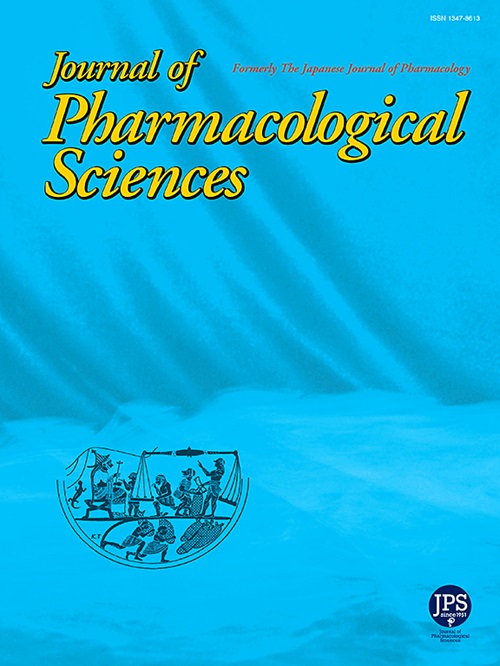Protective role of orphan G protein-coupled receptor GPR35 in the pathogenesis of colitis through regulating epithelial barrier function and immune responses
IF 2.9
3区 医学
Q2 PHARMACOLOGY & PHARMACY
引用次数: 0
Abstract
Background and objective
GPR35 is involved in the pathogenesis of colitis. However, because GPR35 is expressed in colonic epithelial and inflammatory/immune cells, its precise protective mechanisms remain unclear. We investigated the role of GPR35 in colitis, especially its relation to epithelial barrier function and inflammatory/immune responses.
Methods
We performed GPR35 knockout (KO) in a dextran sodium sulfate (DSS)-induced murine colitis model and elucidated the role of GPR35 through various experiments, including histological analysis, intestinal permeability, immunohistochemical staining, RT-qPCR, and western blotting.
Results
GPR35KO mice exhibited significantly exacerbated DSS-induced colitis, accompanied by upregulation of cytokines, compared with wild-type (WT) mice. An investigation using bone marrow (BM)-chimeric mice revealed that GPR35KO, which is expressed in both hematopoietic and non-hematopoietic cells, contributed to this exacerbation. GPR35KO mice showed significantly increased intestinal permeability compared with WT mice under normal conditions. Although no differences were observed in goblet cell number or epithelial proliferation between WT and GPR35KO mice, the expression levels of intercellular junction proteins were significantly lower in the normal colons of GPR35KO mice. Lipopolysaccharide-stimulated cytokine expression was significantly enhanced in BM-derived macrophages obtained from GPR35KO mice compared with WT mice.
Conclusions
GPR35 contributes to colonic protection by regulating epithelial barrier function and inflammatory/immune responses.
孤儿G蛋白偶联受体GPR35通过调节上皮屏障功能和免疫应答在结肠炎发病中的保护作用
背景与目的vegpr35参与结肠炎的发病机制。然而,由于GPR35在结肠上皮细胞和炎症/免疫细胞中表达,其确切的保护机制尚不清楚。我们研究了GPR35在结肠炎中的作用,特别是它与上皮屏障功能和炎症/免疫反应的关系。方法对葡聚糖硫酸钠(DSS)诱导的小鼠结肠炎模型进行GPR35基因敲除(KO),并通过组织学分析、肠通透性、免疫组化染色、RT-qPCR和western blotting等实验来阐明GPR35的作用。结果与野生型(WT)小鼠相比,gpr35ko小鼠表现出明显加重的dss诱导的结肠炎,并伴有细胞因子上调。一项使用骨髓(BM)嵌合小鼠的研究表明,在造血细胞和非造血细胞中表达的GPR35KO导致了这种恶化。与正常情况下的WT小鼠相比,GPR35KO小鼠的肠通透性明显增加。虽然WT和GPR35KO小鼠在杯状细胞数量和上皮细胞增殖方面没有差异,但GPR35KO小鼠正常结肠中细胞间连接蛋白的表达水平明显降低。与WT小鼠相比,GPR35KO小鼠脑源性巨噬细胞中脂多糖刺激的细胞因子表达显著增强。结论sgpr35通过调节上皮屏障功能和炎症/免疫反应参与结肠保护。
本文章由计算机程序翻译,如有差异,请以英文原文为准。
求助全文
约1分钟内获得全文
求助全文
来源期刊
CiteScore
6.20
自引率
2.90%
发文量
104
审稿时长
31 days
期刊介绍:
Journal of Pharmacological Sciences (JPS) is an international open access journal intended for the advancement of pharmacological sciences in the world. The Journal welcomes submissions in all fields of experimental and clinical pharmacology, including neuroscience, and biochemical, cellular, and molecular pharmacology for publication as Reviews, Full Papers or Short Communications. Short Communications are short research article intended to provide novel and exciting pharmacological findings. Manuscripts concerning descriptive case reports, pharmacokinetic and pharmacodynamic studies without pharmacological mechanism and dose-response determinations are not acceptable and will be rejected without peer review. The ethnopharmacological studies are also out of the scope of this journal. Furthermore, JPS does not publish work on the actions of biological extracts unknown chemical composition.

 求助内容:
求助内容: 应助结果提醒方式:
应助结果提醒方式:


